

Zitierweise / cite as:
Carakasaṃhitā: Ausgewählte Texte aus der Carakasaṃhitā / übersetzt und erläutert von Alois Payer <1944 - >. -- Anhang A: Pflanzenbeschreibungen. -- Linum usitatissimum L. -- Fassung vom 2007-07-13. -- URL: http://www.payer.de/ayurveda/pflanzen/linum_usitatissimum.htm
Erstmals publiziert: 2006-07-13
Überarbeitungen:
Anlass: Lehrveranstaltung SS 2007
©opyright: Dieser Text steht der Allgemeinheit zur Verfügung. Eine Verwertung in Publikationen, die über übliche Zitate hinausgeht, bedarf der ausdrücklichen Genehmigung des Verfassers
Dieser Text ist Teil der Abteilung Sanskrit von Tüpfli's Global Village Library
WARNUNG: dies ist der Versuch einer
Übersetzung und Interpretation eines altindischen Textes. Es ist keine
medizinische Anleitung. Vor dem Gebrauch aller hier genannten Heilmittel wird
darum ausdrücklich gewarnt. Nur ein erfahrener, gut ausgebildeter ayurvedischer
Arzt kann Verschreibungen und Behandlungen machen!
Falls Sie die diakritischen Zeichen nicht dargestellt bekommen, installieren Sie eine Schrift mit Diakritika wie z.B. Tahoma.
Verwendete und zitierte Werke siehe: http://www.payer.de/ayurveda/caraka0001.htm
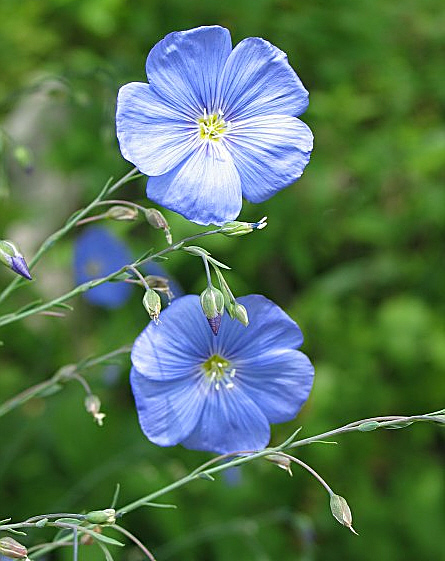
Abb.: Saatlein - Linum usitatissimum L.
[Bildquelle. Wikipedia]
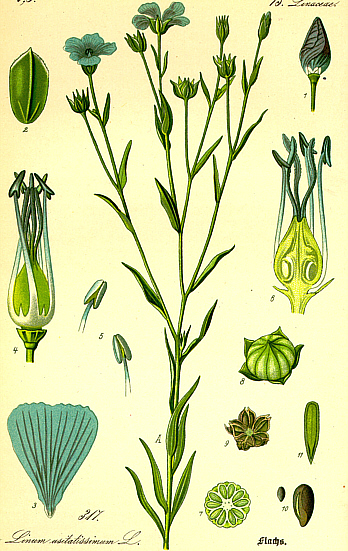
Abb.: Saatlein - Linum usitatissimum L.
[Bildquelle. Wikipedia]
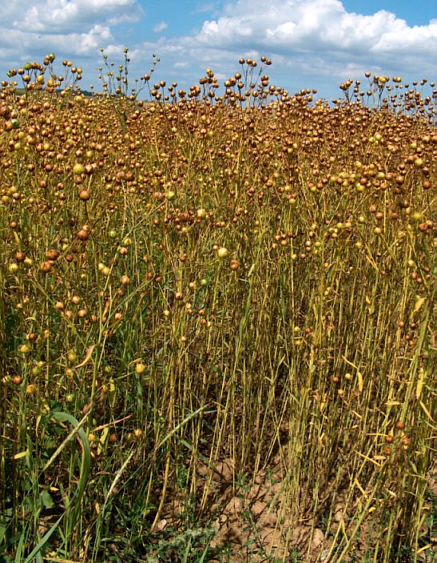
Abb.: Reifer Lein
[Bildquelle. Wikipedia]
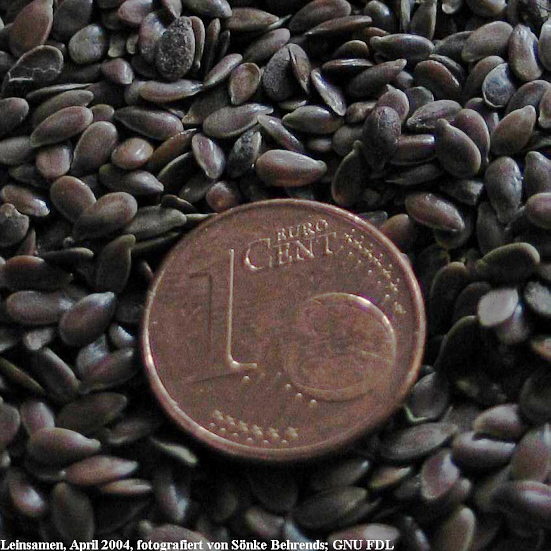
Abb.: Leinsamen
[Bildquelle: Wikipedia]
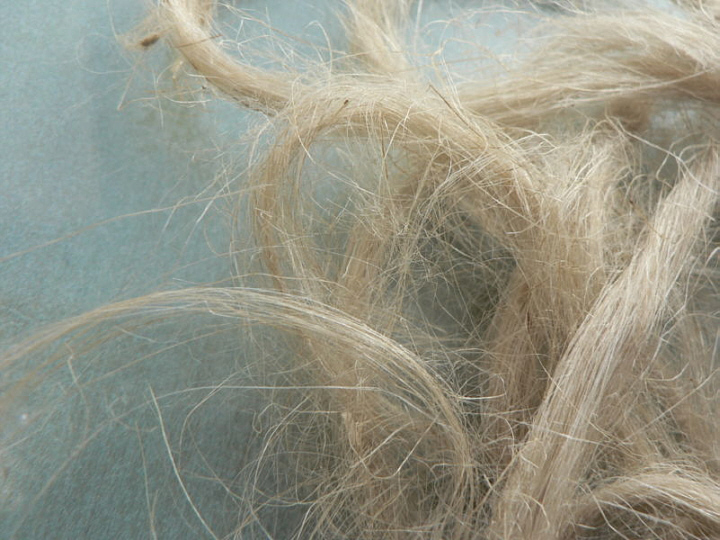
Abb.: Flachsfasern
[Bildquelle. Wikipedia]
Drury:
"Linum usitatissimum (Linn.) N. O. Linaceae Common Flax, Eng. Alleeveray, Tam. Musina, Beng. Tisi, Hind. Ulsee, Description.—Annual, erect, glabrous; leaves alternate, lanceolate or linear, acute, entire; panicles corymbose ; sepals ovate, acute or mucronate, with scarious or membranaceous margins; petals slightly crenated, three times larger than the calyx; stamens alternate with the petals, having their filaments united together near their basis; capsule roundish, pointed at the apex, 5-celled, each cell divided into two partitions, containing a single seed; seeds oval, smooth, brown or white, mucilaginous outside, with oily and farinaceous kernels; flowers blue. Fl. Dec—Feb.— W. & A. Prod. i. 134.—Roxb. Fl. Ind. ii. 100.-------Neilgherries. Cultivated in Northern India.
Medical Uses.—An oil is expressed from the seeds without heat As the oil made in India has not the full drying properties of that prepared in Europe, a considerable quantity of the seeds is imported. This arises from the Indian seeds being mixed with those of mustard, with which they are grown, the mixture deteriorating the quality of the oil. The oil-cake made from the seeds after the expression of the oil is very fattening food for cattle. Linseed-meal is the cake coarsely pulverised, and is used for making emollient poultices. European practitioners in this country consider Unseed a valuable demulcent, according to Ainslie, and is useful in diarrhoea, catarrh, dysentery, and visceral obstructions. A decoction of the seeds forms an excellent enema in abrasion of the Intestines. The meal of the seeds is used for cataplasms; the oil mixed with lime-water (carron oil) has been a favourable application to burns and scalds.' Linseed-oil is one of the chief ingredients in oil varnishes and painters' inks; by boiling with litharge its drying properties are much improved. The inferior seeds which are not sufficiently good for oil are boiled and made into a flax-seed jelly, esteemed an excellent nutriment for stock. Linseed contains l-5th of mucilage, 1 -6th of fixed oil. The former resides entirely in the skin, and is separated by infusion or decoction, the latter by expression.—Simmonds. Ainslie.
Economic Uses.—The native country of the flax-plant is unknown, though it has been considered as indigenous to Central Asia, from whence it has spread to Europe, as well as to the surrounding Oriental countries. For centuries it has been cultivated in India, though, strange to say, for its seeds alone ; whereas in Europe it is chiefly sown for the sake of its fibres. The best flax comes from Russia, Belgium, and of late years from Ireland, where it has been cultivated with the greatest success. Much attention has lately been directed to the sowing of the flax-plant in India for the sake of the fibres; and although the experiments hitherto made have not in every case met with that success which was anticipated, yet there seems little reason to doubt that when the causes of the failure are well ascertained, and the apparent difficulties overcome, that flax will be as profitably cultivated on the continent of India as it is in Europe; while European cultivators must eventually supersede the ryots, whose obstinate prejudice to the introduction of novelty is fatal to any improvement at their hands.
As their object is solely to plant for the seeds alone, they generally mix the latter with other crops, usually mustard, a system which could never be persisted in when the object is for fibres. Among those parts of India where flax has best succeeded may be mentioned the Saugor and Nerbudda territories, Burdwan and Jubbulpore. In the former districts especially the rich soil and temperate climate are peculiarly favourable for its growth. In the Punjaub also its cultivation has been attended with the most successful results, as appears from the report of Dr Jamieson, who says: " For some years I have been cultivating flax on a small scale, from seeds procured from Russia, and its fibres have been pronounced by parties in Calcutta of a very superior description. There is nothing to prevent this country from supplying both flax and hemp on a vast scale. In the Punjaub thousands of acres are available; and from the means of producing both flax and hemp, this part of India will always be able to compete with other countries." In the Madras Presidency it has been grown with the best results on the Neilgherries and Shevaroy Hills, near Salem ; and it would probably succeed equally well wherever the temperature is low, accompanied with considerable moisture in the atmosphere. The chief reason of the failures of the crops in Bengal and Behar was owing to the want of sufficient moisture after the cessation of the rains during the growth of the plant In the Bombay Presidency it has been grown for the seeds alone. In India the time of sowing is the autumn. The soil should be of that character which retains its moisture, though not in an excessive degree. If not rich, manure must be amply supplied, and the plant kept free from all weeds. The best seeds procurable should be selected, of which the Dutch and American are reckoned superior for this country. Dr Roxburgh was the first who attempted the cultivation of flax in India In the early part of this century he had an experimental farm in the neighbourhood of Calcutta. Since his day the improvements which have taken place, resulting from extended observation and. experience, have of course been very great, and specimens of flax which have been sent from Calcutta to the United Kingdom have been valued at rates varying from £30 to £60 a-ton.
The following information on the mode of the culture of flax in India is selected from a report made by Mr Denreef, a Belgian farmer, whose practical experience in this country enabled him to be a correct judge, and whose report is printed entire in the Journal of the Agri-Horticultural Society of Bengal. Such portions of land as are annually renewed by the overflowing of the Ganges, or which are fresh and rich, are the best adapted for the cultivation of flax.
After the earth has been turned up twice or thrice with the Indian plough, it must be rolled; became without the aid of the roller the large clods cannot be reduced, and the land rendered fine enough to receive the seed. The employment of the roller, both before and after sowing, hardens the surface of the earth, by which the moisture of the soil is better preserved, and more sheltered from the heat of the sun. About and near Calcutta, where manure can be obtained in great abundance for the trouble of collecting it, flax may be produced of as good a quality as in any part of Europe.
Manure is the mainspring of cultivation. It would certainly be the better, if the earth be Well manured, to sow first of all either Sunn (Indian hemp), or hemp, or rice, or any other rainy-season crop; and when this has been reaped, then to sow the flax. The tillage of the land by means of the spade (mamoty) used by the natives (a method which is far preferable to the labour of the plough), with a little manure and watering at proper seasons, will yield double the produce obtainable from land tilled without manure and irrigation.
The proper time to sow the flax in India is from the beginning of October until the 20th of November, according to the state of the soil The culture must be performed, if possible, some time before the soil. The flax which I have sown in November was generally much finer and much longer than that sown in the former month, which I attributed to the greater fall of dew during the time it was growing. The quantity of country seed required to the Bengal beega is twenty seers, but only fifteen seers of the foreign seed, because it is much smaller and produces larger stalks. The latter should be preferred; it is not only more productive in flax, but, owing to the tenderness of its stalks, it can be dressed much more easily.
The flax must be pulled up by the roots before it is ripe, and while the outer bark is in a state of fusibility. This is easily known by the lower part of the stalks becoming yellow; the fusion or disappearing of the outer bark is effected during the steeping, which may bo fixed according to the temperature; say, in December at six days, in January five, in February four days, and less time during the hot season. The steeping is made a day after the pulling, when the seed is separated, and then the stalks are loosely bound in small sheaves, in the same way as the Sunn, The Indians understand this business very well, but in taking the flax out of the water it should be handled softly and with great care, on account of the tenderness of its fibres. When it is newly taken out, it should be left on the side of the steeping-pit for four hours, or until the draining of its water has ceased. It is then spread out with the root-ends even turned once, and when dry it is fit for dressing or to be stapled.
To save the seed, the capsules, after they are separated from the stalks, should be put in heaps to ferment from twenty-four to thirty hours, and then dried slowly in the sun to acquire their ripeness.
When flax is cultivated for the seed alone, the country flax should be preferred Six seers per beega are sufficient for the sowing. It should be sown very early in October, and taken up, a little before perfect ripeness, by its roots, separately, when it is mixed with mustard seeds: the flax seed, being intended for the purpose of drying oil, is greatly injured by being mixed with mustard seed, by which mixture its drying qualities are much deteriorated.
The oil which is procured from the seeds, and known .a3 Linseed oil, is obtained in two ways—either cold drawn, when it is of a pale colour, or by the application of heat at a temperature of not less than 200°. This latter is of a deeper yellow or brownish colour, and is disagreeable in its odour. One bushel of East Indian seeds will yield 14| lb. of oil; of English seeds, from 10 to 12 1b. Nearly 100,000 quarters of seeds are annually exported to Great Britain for the sake of the oil they contain. Great quantities are also shipped from Bombay, where the plant is cultivated for the sake of its seeds alone. The export of linseed from Bombay, says Dr Royle, is now' estimated at an annual value of four lacs of rupees.—Simmonds. Ainslie. Lindley."
[Quelle: Drury, Heber <1819 - 1872>: The useful plants of India : with notices of their chief value in commerce, medicine, and the arts. -- 2d ed. with additions and corrections. London : Allen, 1873. -- xvi, 512 p. ; 22 cm. -- s.v.]